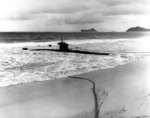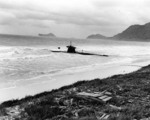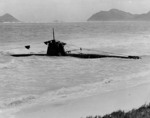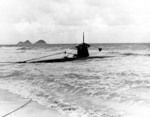Type A-class Midget Submarine
| Country | Japan |
| Displacement | 46 tons full |
| Length | 78 feet |
| Beam | 6 feet |
| Draft | 10 feet |
| Machinery | Battery/electric (600hp), two counter-rotating screws |
| Speed | 23 knots |
| Range | 100nm at 2 knots, 80nm at 6 knots, 18nm at 19 knots |
| Crew | 2 |
| Armament | 2x450mm muzzle-loaded torpedoes, 1x140kg scuttling charge |
| Submerged Speed | 19 knots |
| Number Built | 60 |
Contributor: David Stubblebine
This article refers to the entire Type A-class; it is not about an individual vessel.
ww2dbaseKo-hyoteki Ko Gata Type-A midget submarines were 78.5 feet long, displaced 46 tons, were armed with two muzzle-loaded torpedoes, and had a crew of two. Normally, they were transported to and from their target areas on the decks of larger Type C1 submarines. About 60 Type A's were built and were the first midgets to be deployed.
ww2dbaseOperational Uses
ww2dbasePearl Harbor – 7-Dec-1941
ww2dbaseFive Ko-hyoteki Type A's armed with type 97 torpedoes were launched from five Type C1 mother-submarines as part of the attack on Pearl Harbor. Their orders were to attack any ships that attempted to leave the harbor.
ww2dbaseOne of these five midget submarines, I-18tou (the midget launched from mother-submarine I-18) was depth-charged in Keehi Lagoon outside Pearl Harbor between the harbor entrance and Honolulu, now under the extended runways of Honolulu International Airport (US Navy divers recovered her wreck on 13-June-1960 with both torpedoes still aboard).
ww2dbaseI-24tou (Ha-19) lost her way due to a malfunctioning gyrocompass, ran up on reefs twice, and finally grounded herself on Waimanalo Beach on Oahu's east shore. The sub was captured with both torpedoes still in her tubes and her commanding officer became the first Japanese POW of the war.
ww2dbaseI-20tou was spotted as it was entering the harbor and was sunk by gunfire from USS Ward (NOAA's Hawaii Undersea Research Laboratory [HURL] located her wreck offshore in August 2002 with both torpedoes still aboard).
ww2dbaseI-22tou entered Pearl Harbor and fired both torpedoes toward USS Curtiss and USS Monaghan just after the air attack started. One torpedo ran aground on Ford Island and the other hit a pier off Pearl City. Monaghan rammed and then depth-charged the sub. (The wreck was recovered shortly after the attack and later in the war was used as fill during an expansion of the Pearl Harbor Submarine Base. The hulk was dug up in the 1960's but reburied almost immediately. According to some sources, the remains of her crew remain aboard.)
ww2dbaseI-16tou remains the most mysterious of the Pearl Harbor midgets, and the most intriguing. I-16tou sent a radio report during the night of December 7th with the code words indicating the attacks had been successful but was never picked up by any of the mother-subs. The submarine's actions that day and her subsequent whereabouts remained a complete mystery for many years. Photographic analysis conducted by independent researchers and published by the United States Naval Institute in 1999 suggested a Type A may have successfully fired torpedoes at USS West Virginia and USS Oklahoma during the air attack; but this continues to be controversial. If this is true, this could only have been I-16tou. Pieces of the broken sub were first observed by HURL researchers in 1992 on the ocean floor just south of Oahu, but their significance was not fully understood for ten more years. I-16tou appears to have been recovered during the war in two pieces, the larger of the two pieces was disassembled by the salvors into two more manageably sized pieces, and then all three pieces were dumped at sea. The sub's scuttling charge appears to have been detonated prior to the wartime recovery. This much of the story was deduced after the pieces were found in 2002 but some of it is still uncertain since no record of the sub's recovery has been located. When the sub's bow section was found in 2001, both torpedo tubes were empty. At least one author asserts there is evidence that both torpedoes were fired from their tubes rather than being removed by the salvors, but this remains speculative.
ww2dbaseSo, five Type A submarines carrying a total of ten Type 97 torpedoes were launched against Pearl Harbor. Six torpedoes are known to have never left their tubes; two were fired in the North Channel but hit no ships; which leaves just the two torpedoes from I-16tou that are not completely accounted for.
ww2dbaseLight Cruiser USS St. Louis reported being fired upon by a midget submarine as she broke out of Pearl Harbor at about 0930-1000 but the "two torpedoes" exploded against a submerged reef before reaching the ship. Destroyers pounded the area of the sub with depth charges as St. Louis continued on her sortie. The written reports from St. Louis are very detailed, very clear, and the captain repeated his account several times; claiming with complete certainty that two torpedoes were fired at his ship and that he could see the midget submarine broaching the surface during the attack. The captain later saw the captured I-24tou and confirmed it was the same type of craft that fired at him on Dec 7th. Nevertheless, information learned since the war has punched some holes in the St. Louis account. In the end, it is very doubtful that St. Louis was fired upon by one of the five midgets, despite Captain Rood's certainty.
ww2dbaseThe photo analysis suggesting a midget might have fired on Battleship Row was first printed in 1999, years before the wrecks of I-20tou or I-16tou were discovered. At the time of publication, four torpedoes had not yet been accounted for; enough for St. Louis to have been fired upon and also Battleship Row. With the discovery of I-20tou in 2002 with both torpedoes still aboard, the question was reduced to which account is more credible: the attack on Battleship Row, the attack on St. Louis, or something else altogether. The proposition that a submarine fired on Battleship Row has been repeated in several forums, but it has, as yet, not gained universal acceptance.
ww2dbaseOn the side of the Battleship Row theory, perhaps the most exhaustive online examination of I-16tou and her fate appears at the truly excellent I-16tou.com website.
ww2dbaseSydney Harbor – 31-May-1942
ww2dbaseAt 0300 on 30 May 1942 one of five large Japanese submarines launched a reconnaissance aircraft northeast of Sydney, Australia. After circling the harbor, the plane returned reporting "battleships and cruisers" in the harbor. In reality, the largest ship present was the heavy cruiser USS Chicago. The flotilla's commander decided to attack the harbor with midget submarines the next night. The next day the five submarines approached Sydney Heads and released three Type A midget submarines at about 0430 to begin their approach to Sydney Harbor.
ww2dbaseThe outer-harbor defenses detected the entry of the first midget submarine at about 2000 hours, but it was not identified until it became entangled in an anti-torpedo net that was suspended between George's Head and Green Point. Before HMAS Yarroma was able to open fire, the submarine's two crew members destroyed their vessel with demolition charges and killed themselves.
ww2dbaseThe second submarine entered the harbor at about 2148 and headed west towards the Harbor Bridge, causing a general alarm to be issued by the Naval Officer in Charge, Sydney. About 200 yards from Garden Island the submarine was fired on by the cruiser Chicago. The submarine then fired its two torpedoes at the cruiser. One torpedo ran ashore on Garden Island but failed to explode. The other passed under the Dutch submarine K9 and struck the harbor bed beneath the depot ship HMAS Kuttabul where it exploded, killing 21 sailors: 19 Royal Australian Navy and 2 Royal Navy. Its mission complete, the submarine then slipped out of the harbor and disappeared (her wreck was located in November 2006 about 20 miles north of the harbor; it is now protected as a war grave).
ww2dbaseThe third submarine was sighted by HMAS Yandra at the entrance to the harbor and was depth-charged. Some four hours later, having recovered, it entered the harbor but it was subsequently attacked with depth charges and sunk in Taylor Bay by vessels of the Royal Australian Navy. Both members of the submarine's crew committed suicide.
ww2dbaseThe two submarines that were recovered from inside the harbor were identical. Their remains were used to reconstruct one complete submarine that toured Australia for a year before being delivered to the Australian War Memorial in Canberra in 1943, where it still remains on display.
ww2dbaseDiego Suarez, Madagascar – 30-May-1942
ww2dbaseJapanese submarines I-10, I-16 and I-20 arrived off Madagascar 29 May 1942. I-10's scout plane spotted the 31,000 ton battleship HMS Ramillies at anchor in Diego Suarez harbor but the aircraft was spotted and Ramillies changed her berth. On 30-May-1942 I-20 and I-16 launched two Type A midget submarines, one of which managed to enter the harbor and fire two torpedoes while under depth charge attack from two corvettes. One torpedo seriously damaged Ramillies, while the second sank an oil tanker British Loyalty (later refloated). Ramillies was later repaired in Durban, South Africa and Plymouth, England before sailing with distinction in the Normandy Invasion.
ww2dbaseOne of the submarines was beached at Nosy Antalikely and the crew moved inland towards their pick-up point near Cape Amber. When they bought food at a village, they were informed upon and they were both were killed by Royal Marines a few days later. The second midget submarine was lost at sea and the body of one its crew washed ashore a day later.
ww2dbaseOther Operations
ww2dbaseType A boats were also employed off Guadalcanal and the Solomon Islands in 1942-43, where they achieved modest success against U.S. shipping. They were deployed around Midway, the Aleutians, the Bismarck Islands, the Philippines, the Marianas, and Okinawa as shore-based defensive units, but their overall effectiveness was negligible at best.
ww2dbaseSources: Wikipedia; Naval History & Heritage Command; Combined Fleet; Japan-101; US Naval Institute; Aerospaceweb.org; DANFS (CL-49); JBarche.
Last Major Revision: Feb 2009
Type A-class Midget Submarine Interactive Map
Photographs
 |  |  |  |
Type A-class Midget Submarine Operational Timeline
| 7 Dec 1941 | Five Japanese Type A Ko-hyoteki-class midget submarines are launched south of Oahu, Hawaii from mother submarines I-16, I-18, I-20, I-22, and I-24 as part of the overall Japanese attack on Pearl Harbor. All five were lost. |
| 30 May 1942 | Before dawn, the floatplane of Japanese submarine I-10 conducted a reconnaissance mission over Diego-Suárez harbor, Madagascar, spotting British battleship HMS Ramillies, a tanker, a freighter, and an ammunition ship. At 1740 hours, I-16 and I-20 launched midget submarines M-16b and M-20b 10 miles from Diego-Suárez. M-20b fired her torpedo at 2025 hours, damaging HMS Ramillies and putting her out of action for a year. At 2120 hours, corvettes HMS Genista and HMS Thyme counterattacked with depth charges but failed to hit the Japanese midget submarines. Shortly after, M-20b fired her second torpedo, sinking British tanker British Loyalty. |
| 31 May 1942 | Japanese submarines I-22, I-24, and I-27 launched three midget submarines 7 miles off of Sydney, Australia. At 2235 hours, one was caught in torpedo nets and was scuttled by her own crew of two (both were killed in the process). The two others continued into Sydney Harbor. |
| 31 May 1942 | Japanese submarine I-10 launched her floatplane for a reconnaissance mission over Diego-Suárez harbor, Madagascar to evaluate damage caused by the midget submarine attack that had taken place during the previous night. |
Did you enjoy this article or find this article helpful? If so, please consider supporting us on Patreon. Even $1 per month will go a long way! Thank you. Share this article with your friends: Stay updated with WW2DB: |
Visitor Submitted Comments
1 Nov 2009 08:39:56 PM
To whom it may concern,
i would like to know where can i buy this model Eu-11's Type A Midget Submarine, if possible larger than 1/72 in Kuala Lumpur.
Thanks.
Kuan
1 Mar 2011 09:06:52 PM
My Dad passed on to me a small gryoscope with Japanese writting and it is enclosed in a small wooden box. How do I find out what this gryoscope actually was for ?
31 May 2011 10:36:56 PM
Interesting article on midget submarines. I have a question however. I remember a comedy movie made back in the 60s that depicts the crew of such a vehicle. One gag that runs throughout the movie is that the sub commander broke the Petty officer's saxifone. He asks everyone he meets if they can fix a broken sax.
I cannot remember the name of the movie but sure would like to see it again. ulao@earthlink.net
11 Feb 2015 10:19:30 AM
great and useful
All visitor submitted comments are opinions of those making the submissions and do not reflect views of WW2DB.
» Ha-19
- » 1,146 biographies
- » 336 events
- » 43,422 timeline entries
- » 1,237 ships
- » 349 aircraft models
- » 207 vehicle models
- » 372 weapon models
- » 123 historical documents
- » 259 facilities
- » 468 book reviews
- » 28,395 photos
- » 432 maps
Winston Churchill
Please consider supporting us on Patreon. Even $1 a month will go a long way. Thank you!
Or, please support us by purchasing some WW2DB merchandise at TeeSpring, Thank you!
9 Mar 2009 11:46:19 AM
Thank you for putting together such an interesting Website.
I recently bought what I was told is a WWII era Japanese Gyroscope. It has oriental writing on it that I can't decipher. Through pictures could you tell me if it is one?
Thank you for your reply.
Sincerely, Teresa Findlay